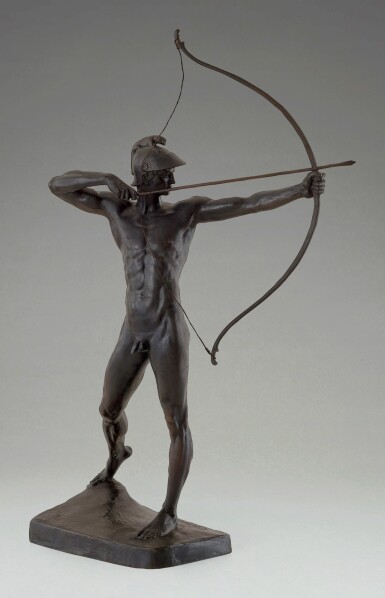European Art: Paintings & Sculpture
European Art: Paintings & Sculpture

ERNST MORITZ GEYGER | BOGENSCHÜTZE (ARCHER)
Lot Closed
June 18, 01:53 PM GMT
Estimate
10,000 - 15,000 GBP
Lot Details
Description
ERNST MORITZ GEYGER
German
1861 - 1941
BOGENSCHÜTZE (ARCHER)
signed: E. M. GEYGER fec and with circular foundry stamp: GARANTIERT ECHTE BRONCE
bronze, dark brown patina
60cm., 24in.
To view Shipping Calculator, please click here
The Bogenschütze is one of Germany’s most iconic and powerful works of sculpture from the turn of the last century. It was conceived soon after Geyger's arrival in Florence in 1895. The artist worked up the monumental 4-metre-high statue from beaten copper and submitted it to the Grosse Berliner Kunstaustellung of 1900 (op. cit., no.1587). It was purchased by Kaiser Wilhelm II in 1902 and installed on a plinth of his design in the Sizilianischen Garten at Sanssouci, Potsdam. It was typical of Geyger's bold experimentation with specialised techniques and mediums to attempt a work in copper: an earlier commission from the Kaiser was a figurative hand-mirror in silver and silver electroplated bronze, which he had cast in Paris; he also took five years to chase his first bronze of A Hippopotamus Attacked by a Lion to emphasise the different surface textures of the animals (Nationalgalerie, Berlin, inv. no. B II 215). When the latter was exhibited in Munich in 1895, it was acclaimed by his friend Max Klinger as 'the first really outstanding German bronze'.
Further to its Royal acquisition, the Bogenschütze proved to be an enormous commercial success and is today Geyger’s most celebrated work. The Gladenbeck foundry acquired the rights to cast reductions in bronze and edited them in three sizes with one such model appearing on the front of their 1903 catalogue. While Geyger's inspiration ultimately derives from antiquity and more specifically from an ancient torso of a wrestler in Berlin (mistakenly restored as an archer), his particular achievement lies in the fresh and modern reinterpretation of the Ideal, harnessing a stylised male physique in a composition full of the undiluted energy in the split second before the release of the archers' arrow. In this, it is at once removed from the austere classicism of the monumental Achilles statue, which the Kaiser commissioned from Johannes Götz for the Achilleion, Corfu.
While chiefly remembered as a sculptor, Geyger was also a highly-skilled printmaker and painter and from 1893, divided his time between graphic and sculptural works. The connection between the two can be seen in the strong linearity and the precise rendering of large surfaces evident in his sculpture. The anatomy of the figure in fact bears strong similarities to a preliminary drawing of The Giant that Geyger executed for a print to illustrate Nietzsche’s parable and published in the second issue of PAN in 1895 (see Shepherd Gallery, op.cit.).
Aside from the cast at Sanssouci, only five other full-size versions of the Bogenschütze are known to exist: a bronze 230cm. version finished for the Rathausvorplatz in Hannover, from which a further replica in bronze was commissioned by Carl Jacobsen (Sportpark, Copenhagen); a copper version of 237cm. given by Geyger's parents to the Arndt-Gymnasium in Berlin-Zehlendorf in 1926 (returned 1983); a bronze or copper version installed on the right embankment of the Elbe in Dresden (re-erected post war) and another, believed to be bronze, in the Ebert-Park in Ludwigshafen (1925).
RELATED LITERATURE
P. Bloch and W. Grzimek, Das Klassische Berlin, Berlin 1978, p. 313, no. 307; Sculpture from the David Daniels Collection, exh. cat. The Minneapolis Institute of Arts, Minneapolis, 1979, nos. 59-60; Ethos und Pathos: die Berliner Bildhauerschule 1786-1914, exh. cat. SMPK, Berlin, 1990, pp. 109-110, 347-348, 459-460, no. 148; R. and E. Kashey, German Drawings 1790-1915, exh. cat. Shepherd Gallery, New York, 1994, no. 59
